Thursday, 22 May 2014: Tallahassee to Paris to Montpellier to Béziers, at the end of an era
Written 22 May
Well, it had to happen eventually. Erin Easton, David's very last graduate student got word at the beginning of May that she had gotten the postdoc position she wanted, in Chile. Great news, but they wanted her there, Yikes!, by the end of the month! No way she could defend her dissertation by then, but she and David went into fast-forward mode, trying to get enough done that she could finish up after leaving. She'll fly back to defend in July, stick around for commencement on 2 August, then head back to Chile for two years.
David has therefore been scrambling to turn her chapters around as soon as she gets them to him, in addition to working on a couple of papers coauthored with his next-to-last grad student, now working on a doctorate in Texas. The last of his undergrad assistants graduated in April and is now a first-year grad student in a lab down the hall.
So Sunday afternoon, when I asked for updates to a draft of our preprinted postcard labels, in preparation for the trip, he added one person, deleted another, then indicated the entry that has been on the list for 37 years—"The Thistle lab, c/o [senior grad student of the moment]"—and said sadly, "You might as well take that one off permanently; there is no Thistle lab any more." Sigh. Academic empty-nest syndrome. The end of an era indeed.
Before retirement, we used to work at least half a day before flying off to Europe, because the flight is always in the evening. Now, we play golf in the morning—otherwise I wake up excited about the trip, then just fidget and second-guess my packing all day. The taxi came promptly (mirabile dictu), so we got to the airport in plent of time. Strangely, though, when we checked in, even though our reservations were made (and the seats chosen) together back in February and shared a confirmation code, the little automatic kiosk issued David's first two boarding passes (Tallahassee to Atlanta and Atlanta to Paris), plus a little notice that he'd have to check in again in Paris, but only one for me, plus a notice that I'd have to check in again in Atlanta! Bizarre enough, but the Atlanta check-in went smoothly enough; they issued me the seat next to David, no problem. They still wouldn't issue our third boarding passes, though—Air France would have to d that.
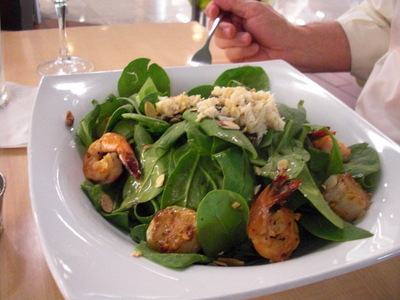
 The last time we were on Atlanta's Concourse F, the only food choices were tacos and Chinese. Now that it's finished, we had other options. We had a light supper at Jekyll Island Seafood, knowing that we wouldn't get anything to eat on the plane until after 10 p.m. We split the smoked salmon appetizer—little warm toasts spread with cream cheese, covered with cold smoked salmon, and sprinkled with capers—very good. Then David had the warm seafood salad (sautéed shrmp, scallops, and crab over baby spinach), and I had the "captain's basket" appetizer (fried seafood and fries—they were out of oysters, so I settled for calamari, as the only other choice was "firecracker buffalo shrimp"). Pretty good.
The last time we were on Atlanta's Concourse F, the only food choices were tacos and Chinese. Now that it's finished, we had other options. We had a light supper at Jekyll Island Seafood, knowing that we wouldn't get anything to eat on the plane until after 10 p.m. We split the smoked salmon appetizer—little warm toasts spread with cream cheese, covered with cold smoked salmon, and sprinkled with capers—very good. Then David had the warm seafood salad (sautéed shrmp, scallops, and crab over baby spinach), and I had the "captain's basket" appetizer (fried seafood and fries—they were out of oysters, so I settled for calamari, as the only other choice was "firecracker buffalo shrimp"). Pretty good.
Our flight to Paris was on an Air France plane, so I was optimistic about the catering, but without reason as it turned out. Seating was strictly cattle-car, with our knees touching the seats in front even before anybody reclined, and the food wasn't even up to Delta's recent standards—rather tired quinoa, corn, and black bean salad followed by not-very-good penne pasta baked in cream sauce with salmon;chilled bread bun; only okay square of coconut cake. Maybe I should have gone with the creamed chicken with mashed potatoes and carrots. David slept through the whole thing.
Charles De Gaulle airport in Paris has definitely improved its signage, but its organization and naming conventions are still baffling. From our arrival gate, terminal 2E, gate M, where the departure board told us our flight to Montpellier would depart from gate "F50," we just followed the signs with the flight-connections icon, and followed them and followed them, through long uninhabited corridors, down multiple escalators, around corners, and down more escalators (and out through one-way security doors) until we came (so far without being offered any choice of route) to sleek new subway cars leading to "L gates," "K gates," and "terminals 2D, 2F, and flight connections." At the far end, still following the "flight connections" icon, which got smaller with each successive sign, we hiked more corridors, went down more escalators (en route, the subway cars had climbed out of their tunnel and back up to second-floor height), turned more corners, again mostly uninhabited (although some of their windows overlooked the bustling and commercial main halls of terminal 2F), until we arrived at the typical large open hall thickly forested with those post-and-ribbon dividers used to form crowds into long zig-zag queues and, beyond them, passport-control booths. We cheerfully presented ourselves, our passports, and our "you must check in again in Paris" notices and were turned back—you can't join this queue without boarding passes; you need to check in again. Yes, but where; other than fellow passengers, we hadn't encountered a person in miles. They didn't know exactly, but they said to go back up the escalator and ask someone where to find the Sky-Team (i.e., Delta and Air France) desk. But, of course, the route we'd been following was so confidently unidirectional that the escalator didn't go back up. David, carrying a backpack, went up the stairs. I, pulling quite a heavy rolling computer case, cheerfully ignored the "staff only" sign and took the elevator. At the top, nothing but an empty landing, so we went up one more flight, and sure enough, there was someone to ask—through there, he said, down the escalator, around the corner to the right, then to the left.
Sure enough, there was a small ticketing hall, with manned airline desks, but entirely devoid of travellers. The nice lady at the Air France desk accepted our "you must check in" slips, said "no problem," starting typing, studied her screen, said "uh-oh," and made a phone call. More typing, another phone call to someone else, more typing, irritated finger-drumming. Called over a colleague. This happens increasingly frequently, they agreed; Delta needs to update its Sky-Team software. Finally, though, after one more phone call, they printed boarding passes, then, on mine, she handwrote a long numeric code and the notation, in French, "to be printed by DL; they have been alerted."
Back up the escalator, across the way, and down two escalators, we joined the queue, passed through passport control, then security, without difficulty, followed more signs and at last arrived at a sign that admitted that "F" could have numbers after it! F50 was all the way down at the end. In France, you just have to have faith and keep following the signs. Of course the signs near the gate directing us to the restrooms didn't mention the long line at the ladies room or the lack of paper therein, nor did the sign on a door nearby, indicating that the room contained a changing table, tell the annoyed mothers rattling the doorknob why it was locked.
Also near the gate I encountered that important item so rare in France, a public drinking fountain. The airport even boasted of it, in a sign on the wall saying how pleased they were to offer the public chilled drinking water whose quality and cleanliness were measured continuously. I filled my water bottle.
While waiting at the gate, I wondered whether we ought to check in at the desk a propos of the notation on my boarding pass, but we didn't. So of course when we boarded (in just two zones—first class and everybody else—we made sure to be at the head of the line) and the agent ran David's pass through the reader, she stopped us, saying "there's some sort of difficulty here. I instantly presented my annotated pass, which elicited an immediate "Ah! No problem. She entered the numeric code into a tiny keypad, pressed a key, the machine read our boarding passes, and she waved us cheerfully through and onto the plane (even Paris's jetways are amazingly long! So, presumably, somewhere in the world, Delta was printing something (our "real" boarding passes?) that finally authorized our travel.
Written 24 May
The highlight of the flight to Montpellier was a clear and beautiful view of the Viaduc de Millau, an amazing bridge over the Tarn gorge, the tallest bridge in the world. We had recently (a propos of this very trip) watched a French TV program about its construction, which was mindboggling. Later in this trip, we'll get to drive over it.
In the small, pleasant, and well-organized Montpellier airport, our luggage appeared just as we reached the carrousel, and just a few steps away we were able to make our two highest-priority purchases—a six-pack of Evian for the car and a local road map—before reporting to the rental-car desk, also only a few steps away. David made a big hit with the Europcar desk agent by speaking French and by being cheerfully patient while she dealt with somebody else's urgent problem in the middle of his transaction. Of the perhaps 20-30 people in front of and behind us in line, every single one spoke British English. (Rachel: Through the open door behind the agent, I could see into the back office, which boasted a lovely pony-tail palm just like yours, only about twice the size.)
Our dark gray VW Polo was waiting just a few steps away, but the Blaupunkt GPS was captioned in German, and changing the settings to English made no difference. Back to the nice desk-agent, who sent someone out to help us. It took a while, but she finally found the right setting, deep inside the set-up routine, that changed it to English, and we set off for Béziers.
We never did find the setting that would make it avoid toll roads, so it wanted to take us by the freeway. David tried to avoid that ignoring the GPS and following the green highway signs (as opposed to the blue ones, meaning toll) to Béziers, and that would presumably have worked, eventually, but made the trip much longer than it needed to be because it embroiled us in a labyrinth of highway construction, detours, tiny country roads, and traffic jams in tiny towns (remember that, in the US, a small town is called a "wide place in the road," whereas in France it is by definition a narrow place in the road, where ancient stone barns and churches were erected when only a single horse and cart had to pass between them). So in the end we allowed the GPS to direct us back onto the freeway and, with its help, found the hotel on the first try (it even had free covered parking).
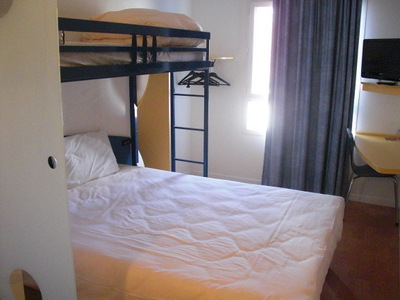
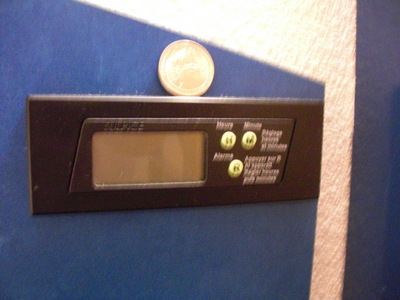 The hotel, the Ibis Budget Béziers Centre Palais Congrès (French hotel names can be as bad as American country church names; every schism adds an adjective), was exactly what you'd expect of an Ibis Budget—clean, comfortable, bare bones. Here's a photo of the bed arrangement. The Accor management must have had about a bazillion of these double-bed-with-crosswise-upper-bunk sets made, for their bottom-of-the-line "Formula 1" hotels and now use them in some Ibis Budgets as well. The upper bunk provides convenient storage and the ladder nice hanging space. At the right is a close-up of the tiny black object set into the headboard just the the right of the pillow in the other photo. I've added a quarter for scale. It's an alarm clock. You hold the lower button while setting the hour and minutes with the upper two. That's it. Very simple. The white panel to the left of the bed is the shower door, standing slightly open.
The hotel, the Ibis Budget Béziers Centre Palais Congrès (French hotel names can be as bad as American country church names; every schism adds an adjective), was exactly what you'd expect of an Ibis Budget—clean, comfortable, bare bones. Here's a photo of the bed arrangement. The Accor management must have had about a bazillion of these double-bed-with-crosswise-upper-bunk sets made, for their bottom-of-the-line "Formula 1" hotels and now use them in some Ibis Budgets as well. The upper bunk provides convenient storage and the ladder nice hanging space. At the right is a close-up of the tiny black object set into the headboard just the the right of the pillow in the other photo. I've added a quarter for scale. It's an alarm clock. You hold the lower button while setting the hour and minutes with the upper two. That's it. Very simple. The white panel to the left of the bed is the shower door, standing slightly open.
After washing up and resting up, we set off on foot for our restaurant, l'Ambassade (a Gault-Millau three-toque). For the first third of the distance, I was saying to myself, "Well, at least it will be mostly downhill on the way back." Then we crested the rise, and no, clearly it wouldn't be. The place was across from the train station at the bottom of a descent so steep that in places the road changed to stairs, but it out to be a real winner. We'll have to check this year's GM guide to see whether it's gotten its fourth toque.
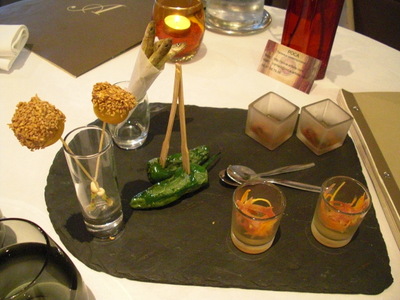
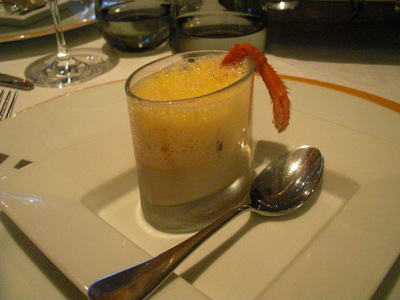 First amuse-bouche: Lollipops of outstanding yellow cherry tomato, dipped in caramel and sesame seeds. Mussels marinated in a spicy tomato-based sauce. Whole fried "jols" (pronounced "jolce"), their heads protruding from a small paper cone. Mild but tasty fried green Spanish "piquillo" peppers. And finally, cold parsnip jelly topped with seasoned finely shredded vegetables. The shredded veggies had more flavor than the parsnip jelly, which was inoffensive but very mild and which we would never have recognized as parsnip flavored. The rest were outstanding. "Jols," sometimes written "joëls," are (Wikipedia tells me) Atherina boyeri, big-scale sand smelts. Each was about 2 inches long (and yummy).
First amuse-bouche: Lollipops of outstanding yellow cherry tomato, dipped in caramel and sesame seeds. Mussels marinated in a spicy tomato-based sauce. Whole fried "jols" (pronounced "jolce"), their heads protruding from a small paper cone. Mild but tasty fried green Spanish "piquillo" peppers. And finally, cold parsnip jelly topped with seasoned finely shredded vegetables. The shredded veggies had more flavor than the parsnip jelly, which was inoffensive but very mild and which we would never have recognized as parsnip flavored. The rest were outstanding. "Jols," sometimes written "joëls," are (Wikipedia tells me) Atherina boyeri, big-scale sand smelts. Each was about 2 inches long (and yummy).
Second amuse-bouche: Cold foie gras custard studded with shitake slivers, topped with a foamy lobster sauce, and decorated with a lobster pereiopod. Wow, was that ever good! As David put it, "Forget the first course; I'll have two more of those, please!"
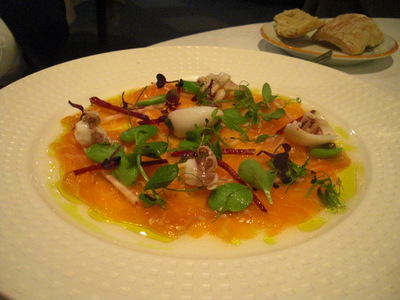
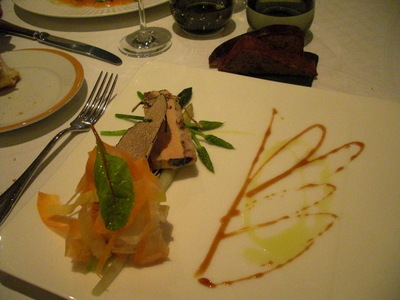 First course, David: But he was glad he didn't actually say that in the waiter's hearing, because the first course also knocked his socks off. It was carpacio of (i.e., thinly sliced) raw wild salmon with pea shoots, citrus vinaigrette, baby fava beans, little grilled squids, olive oil, and "sakura." That last (Wikipedia tells me) is Japanese cherry trees or their blossoms and also the name of myriad Japanese restaurants worldwide, including one in Béziers. So is some part of a Japanese cherry tree used as a seasoning? Or are the salmon slices supposed to look like cherry-blossom petals? Or do they get their raw wild salmon from the nearby sushi restaurant? No idea.
First course, David: But he was glad he didn't actually say that in the waiter's hearing, because the first course also knocked his socks off. It was carpacio of (i.e., thinly sliced) raw wild salmon with pea shoots, citrus vinaigrette, baby fava beans, little grilled squids, olive oil, and "sakura." That last (Wikipedia tells me) is Japanese cherry trees or their blossoms and also the name of myriad Japanese restaurants worldwide, including one in Béziers. So is some part of a Japanese cherry tree used as a seasoning? Or are the salmon slices supposed to look like cherry-blossom petals? Or do they get their raw wild salmon from the nearby sushi restaurant? No idea.
With that course David had the first of two local white wines by the glass that the waiter recommended to accompany the dishes he ordered; David raved about both, adding that that first one continued to improve throughout the rest of the meal as it "opened up" with warmth and breathing. The waiter wrote down the names for him.
First course, me: Cold foie gras pressed into a loaf with bits of smoked duck breast and duck cracklings, served with green, white, and wild asparagus, streaks of beet vinegar, white-truffle slices, and what the menu called "glacial" vegetables; veggies sliced infinitessimally thin and soaked in ice water until extremely crisp.
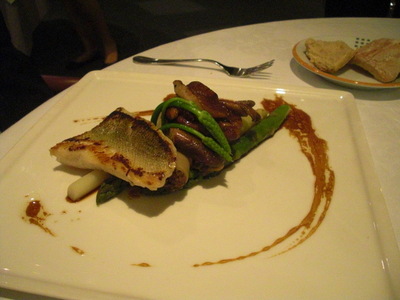
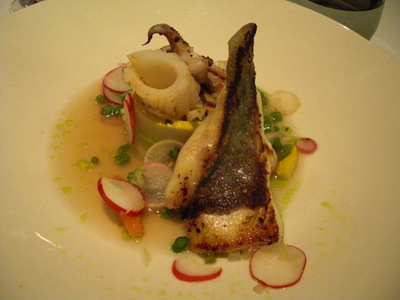 Main course, David: One of the evening's specials, sandre (Lucioperca lucioperca, a fresh-water pike perch) pan-roasted on its skin with mushroom canneloni, sautéed mushrooms, and the three asparaguses. Excellent.
Main course, David: One of the evening's specials, sandre (Lucioperca lucioperca, a fresh-water pike perch) pan-roasted on its skin with mushroom canneloni, sautéed mushrooms, and the three asparaguses. Excellent.
Main course, me: St. Pierre (Zeus faber, John Dory) pan-roasted on its skin, in a "bouillabaisse broth" with slivered vegetables and slivered squid. The latter are contained within a cylinder made of strips of cooked yellow and green zucchini and topped with a piece of scored grilled squid and squid tentacles. Delicious.
The cheese trolley was vast and well stocked (and, fortunately, serving portions were restrained). David chose Roquefort, Comté, and Brillat-Savarin. I had Pouligny St. Pierre, Pérail, Rocadamour, and Salers. For those of you who remember the "velvet rose" that Desirée Wehner used to make at Sweet Grass Dairy, Pérail was the effect she was aiming at (and coming pretty darn close to, even though it's made with ewe's milk and she was working only with cow's and goat's milk). All exquisite, although David complained that his Roquefort was too salty.
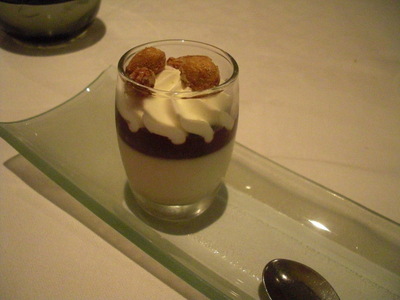
 Predessert, both: A small supposedly peanut-flavored custard topped with chocolate cream, in turn topped with vanilla-flavored whipped cream and a few roasted peanuts. Good but very rich. And the peanut flavor was very subtle compared to, e.g., a Reese's cup.
Predessert, both: A small supposedly peanut-flavored custard topped with chocolate cream, in turn topped with vanilla-flavored whipped cream and a few roasted peanuts. Good but very rich. And the peanut flavor was very subtle compared to, e.g., a Reese's cup.
Dessert, David: A chocosphere, of course, which he always orders when it's on the menu. This one was banana flavored. It was filled with chocolate ganache and a fluffy white filling and accompanied by a chunk of frozen banana on a stick that had been dipped in chocolate and nuts.
Dessert, me (showed at right): A "revisited" Paris-Brest. Good but not, in my opinion, an improvement on the original. A standard Paris-Brest (named for the famous annual bicycle race), intended to feed sevral people, is usually a large, ring-shaped (i.e., bicycle-wheel shaped) cream puff split and filled with fluffy caramel-almond (i.e. "praliné") cream. This one was a single large and a single small cream puff, supposedly filled with a light almond cream and accompanied by "praliné" ice cream. Alas, the ice cream was almost melted, and the cream in the puffs was in two phases, both pretty sticky. The objects sticking out of the large puff are (1) a rod of chocolate ganache rolled in crushed cocoa nibs (excellent) and (2) a thin, spiraled, ornamental chocolate cookie (less so).
We had to give up on the desserts; they were just too much. Either the predessert or the dessert should have been strawberry rather than chocolate.
Then, while we waited for the check, the junior waiter showed up with a large platter filled with mignardises, tongs poised to serve us as many as we wanted. I accepted a tiny triangle of almond-topped puff pastry and a miniature walnut loaf cake. David got the same almond thing and a tiny chocolate tart topped with one fresh cherry.
We'd go back there in a minute if we were ever planning to be Béziers again. Highly recommended. The waiter was very flattered when I said it was unfortunate to start off at such a high level—successive dinners would have trouble measuring up.
We had planned to walk home, but in the end we didn't have to face that steep hill. As we emerged, it was beginning to rain, so we had the maitre d' hail us a cab from the rank at the station, which took us home in style.
previous entry
List of Entries
next entry

 The last time we were on Atlanta's Concourse F, the only food choices were tacos and Chinese. Now that it's finished, we had other options. We had a light supper at Jekyll Island Seafood, knowing that we wouldn't get anything to eat on the plane until after 10 p.m. We split the smoked salmon appetizer—little warm toasts spread with cream cheese, covered with cold smoked salmon, and sprinkled with capers—very good. Then David had the warm seafood salad (sautéed shrmp, scallops, and crab over baby spinach), and I had the "captain's basket" appetizer (fried seafood and fries—they were out of oysters, so I settled for calamari, as the only other choice was "firecracker buffalo shrimp"). Pretty good.
The last time we were on Atlanta's Concourse F, the only food choices were tacos and Chinese. Now that it's finished, we had other options. We had a light supper at Jekyll Island Seafood, knowing that we wouldn't get anything to eat on the plane until after 10 p.m. We split the smoked salmon appetizer—little warm toasts spread with cream cheese, covered with cold smoked salmon, and sprinkled with capers—very good. Then David had the warm seafood salad (sautéed shrmp, scallops, and crab over baby spinach), and I had the "captain's basket" appetizer (fried seafood and fries—they were out of oysters, so I settled for calamari, as the only other choice was "firecracker buffalo shrimp"). Pretty good.
 The hotel, the Ibis Budget Béziers Centre Palais Congrès (French hotel names can be as bad as American country church names; every schism adds an adjective), was exactly what you'd expect of an Ibis Budget—clean, comfortable, bare bones. Here's a photo of the bed arrangement. The Accor management must have had about a bazillion of these double-bed-with-crosswise-upper-bunk sets made, for their bottom-of-the-line "Formula 1" hotels and now use them in some Ibis Budgets as well. The upper bunk provides convenient storage and the ladder nice hanging space. At the right is a close-up of the tiny black object set into the headboard just the the right of the pillow in the other photo. I've added a quarter for scale. It's an alarm clock. You hold the lower button while setting the hour and minutes with the upper two. That's it. Very simple. The white panel to the left of the bed is the shower door, standing slightly open.
The hotel, the Ibis Budget Béziers Centre Palais Congrès (French hotel names can be as bad as American country church names; every schism adds an adjective), was exactly what you'd expect of an Ibis Budget—clean, comfortable, bare bones. Here's a photo of the bed arrangement. The Accor management must have had about a bazillion of these double-bed-with-crosswise-upper-bunk sets made, for their bottom-of-the-line "Formula 1" hotels and now use them in some Ibis Budgets as well. The upper bunk provides convenient storage and the ladder nice hanging space. At the right is a close-up of the tiny black object set into the headboard just the the right of the pillow in the other photo. I've added a quarter for scale. It's an alarm clock. You hold the lower button while setting the hour and minutes with the upper two. That's it. Very simple. The white panel to the left of the bed is the shower door, standing slightly open.
 First amuse-bouche: Lollipops of outstanding yellow cherry tomato, dipped in caramel and sesame seeds. Mussels marinated in a spicy tomato-based sauce. Whole fried "jols" (pronounced "jolce"), their heads protruding from a small paper cone. Mild but tasty fried green Spanish "piquillo" peppers. And finally, cold parsnip jelly topped with seasoned finely shredded vegetables. The shredded veggies had more flavor than the parsnip jelly, which was inoffensive but very mild and which we would never have recognized as parsnip flavored. The rest were outstanding. "Jols," sometimes written "joëls," are (Wikipedia tells me) Atherina boyeri, big-scale sand smelts. Each was about 2 inches long (and yummy).
First amuse-bouche: Lollipops of outstanding yellow cherry tomato, dipped in caramel and sesame seeds. Mussels marinated in a spicy tomato-based sauce. Whole fried "jols" (pronounced "jolce"), their heads protruding from a small paper cone. Mild but tasty fried green Spanish "piquillo" peppers. And finally, cold parsnip jelly topped with seasoned finely shredded vegetables. The shredded veggies had more flavor than the parsnip jelly, which was inoffensive but very mild and which we would never have recognized as parsnip flavored. The rest were outstanding. "Jols," sometimes written "joëls," are (Wikipedia tells me) Atherina boyeri, big-scale sand smelts. Each was about 2 inches long (and yummy).
 First course, David: But he was glad he didn't actually say that in the waiter's hearing, because the first course also knocked his socks off. It was carpacio of (i.e., thinly sliced) raw wild salmon with pea shoots, citrus vinaigrette, baby fava beans, little grilled squids, olive oil, and "sakura." That last (Wikipedia tells me) is Japanese cherry trees or their blossoms and also the name of myriad Japanese restaurants worldwide, including one in Béziers. So is some part of a Japanese cherry tree used as a seasoning? Or are the salmon slices supposed to look like cherry-blossom petals? Or do they get their raw wild salmon from the nearby sushi restaurant? No idea.
First course, David: But he was glad he didn't actually say that in the waiter's hearing, because the first course also knocked his socks off. It was carpacio of (i.e., thinly sliced) raw wild salmon with pea shoots, citrus vinaigrette, baby fava beans, little grilled squids, olive oil, and "sakura." That last (Wikipedia tells me) is Japanese cherry trees or their blossoms and also the name of myriad Japanese restaurants worldwide, including one in Béziers. So is some part of a Japanese cherry tree used as a seasoning? Or are the salmon slices supposed to look like cherry-blossom petals? Or do they get their raw wild salmon from the nearby sushi restaurant? No idea.
 Main course, David: One of the evening's specials, sandre (Lucioperca lucioperca, a fresh-water pike perch) pan-roasted on its skin with mushroom canneloni, sautéed mushrooms, and the three asparaguses. Excellent.
Main course, David: One of the evening's specials, sandre (Lucioperca lucioperca, a fresh-water pike perch) pan-roasted on its skin with mushroom canneloni, sautéed mushrooms, and the three asparaguses. Excellent.
 Predessert, both: A small supposedly peanut-flavored custard topped with chocolate cream, in turn topped with vanilla-flavored whipped cream and a few roasted peanuts. Good but very rich. And the peanut flavor was very subtle compared to, e.g., a Reese's cup.
Predessert, both: A small supposedly peanut-flavored custard topped with chocolate cream, in turn topped with vanilla-flavored whipped cream and a few roasted peanuts. Good but very rich. And the peanut flavor was very subtle compared to, e.g., a Reese's cup.